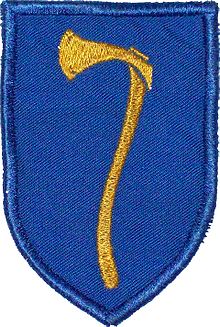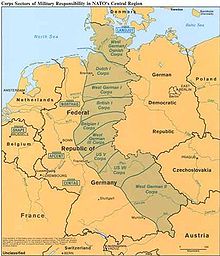- Northern Army Group
-
The Northern Army Group (NORTHAG) was a NATO military formation comprising four Western European Army Corps, during the Cold War as part of NATO's forward defence in the Federal Republic of Germany.
Contents
History
NORTHAG's headquarters was established on 1 November 1952 in Bad Oeynhausen, but was relocated in 1954 to Rheindahlen. At the location Munchengladbach was NORTHAG HQ with three other command posts, the headquarters of the 2nd Allied Tactical Air Force (2 ATAF), the headquarters of the British Army of the Rhine (BAOR) and the headquarters of RAF Germany (RAFG).
Badge
During the construction of the main building of the joint HQ, the JHQ (Joint Headquarters), a Frankish battle ax (Franziska) was found. It was the badge NORTHAG chose because the Franks were a West-European tribe fighting against attackers from the East. The Franks defeated in the year 451 AD, an army under the leadership of Attila in Châlons-sur-Marne and ended thus a conquest of Western Europe by the Huns.
Organization
In the NATO command structure NORTHAG belonged to Allied Forces Central Europe (AFCENT), which in turn reported to Supreme Headquarters Allied Powers Europe (SHAPE).
Commander in Chief of the HQ NORTHAG was basically a British General and Chief of the British Rhine Army (BAOR). Chief of Staff was a German Major General, with the Belgian and Dutch Major-General as alternates.
The HQ NORTHAG were assigned the following national formations:
- The I Belgian Corps,
- The I British Corps
- The I Dutch Corps (included First Division 7 December, 4th, and 5th Divisions in 1985)[1]
- The I German Corps (from 1957).
These organizations fell in peacetime under their respective national command authorities. Only in the case of attack did overall management authority over the Corps transfer to the NORTHAG HQ. Air support was channeled through 2 ATAF.
HQ NORTHAG had under its authority multi-national staff personnel, even in peacetime, and the following national units under control:
- The 13th Belgian Telecommunications Company (13 Cie T Tr)
- The 28th Signal Regiment, Royal Signals (NORTHAG)
- The German Telecommunications Battalion 840 (NORTHAG)
- A Dutch telecommunications company and the
- NORTHAG telecommunications company (radio NORTHAG Air Support Squadron), which consisted of soldiers from all four nations.
Intern was responsible for the communication between the headquarters and the associations, the responsible NORTHAG signal group. This was a multinational grouping, which the subordinate telecommunication organizations served, each a different type of connection required (relay, cable, etc.).
In the case of war the headquarters of the 2nd ATAF and NORTHAG would be relocated to the JOC (Joint Operations Center), a bunker complex in the St. Pietersberg in Maastricht area.
Field Operations
In the NATO defense plan, NORTHAG was assigned the area between Hamburg and Kassel (North-South) and the German-Dutch, Belgian to the (then) inner-German border to defend against a potential threat from the Warsaw Pact. The locations of NORTHAG forces were accordingly, mostly in this area. In the north the command bordered Allied Forces Northern Europe (AFNORTH) and in the south the Central Army Group (CENTAG).
Ground operations relating to the crisis in former Yugoslavia began in late 1992. In November 1992, the UN Protection Force in Bosnia-Herzegovina was provided with an operational headquarters drawn from HQ NORTHAG, including a staff of some 100 personnel, equipment, supplies and initial financial support.
Disbandment
On 24 June 1993, the headquarters of NORTHAG and 2 ATAF officially disbanded during a military ceremony. The last commander of NORTHAG was General Sir Charles Guthrie, KCB LVO OBE.[2] The last Chief of Staff was Major General Helmut Willmann, later commander of the Eurocorps.
References
- ^ David Isby and Charles Kamps, Armies of NATO's Central Front, Jane's Publishing Company, 1985, p.331-3
- ^ NATO profile: Sir Charles Guthrie
- "Army Group North brochure Editor: HQ NORTHAG 1987
- "The five headquarters in Mönchengladbach", brochure monk Koblenz-Verlag, 1987
- "The History of the Northern Army Group", Editor: HQ NORTHAG, 1993
Further reading
- David G. Haglund and Olaf Mager (eds), Homeward bound? : allied forces in the new Germany, Westview Press, 1992. xi, 299 p. : ill. ; 22 cm. ISBN 0813384109.
External links
Categories:- Wikipedia articles needing cleanup after translation
- Military units and formations of NATO
Wikimedia Foundation. 2010.


